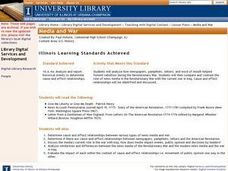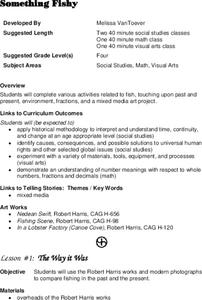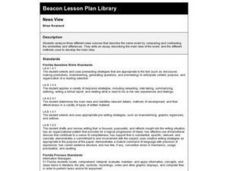Curated OER
Is It Ethical to Eat Meat?
Have your class join a blog about whether or not eating meat is good for you. They'll read several passages regarding meat processing and consumption, then they post what they think. There are six critical-thinking prompts to help them...
Newseum
Persuasion Portfolios
After class members brainstorm a list of current social and political issues, groups each select a different topic from the list to research. Teams create a portfolio of at least 10 examples of stories about their issue, stories that...
Curated OER
The Library Caper
Fifth graders use a graphic organizer to identify polices and procedures for borrowing library media center materials. They demonstrate the ability to locate, retrieve, and handle media and equipment. Students demonstrate an appreciation...
Curated OER
Mass Manipulation
Students make a chart of the media's manipulation techniques and examples of them while watching and listening to a video tape of past news events.
Curated OER
Media and War
Students investigate how written media and word of mouth helped foment rebellion during the Revolutionary War. They compare and contrast that with the role of the news media in the war in Iraq focusing on cause and effect relationships.
Curated OER
Using News Broadcasts in Japan and the U.S as Cultural Lenses
High schoolers view archives of news broadcasts in order to create a context of cultural understanding. They compare and contrast the news broadcasts in Japan and the United States.
iCivics
Step Nine: Action Campaign
It's time to take action! Learners strategize their action campaigns by using the resource and past brainstorming activities from the series that help them pinpoint problems in their communities. They use included templates to get the...
Curated OER
The Student Cafateria as the "Leafy Chestnut Tree"
Students examine the difference between "news" of earlier periods, and "news" as we know it today. They then go out into the school common areas and analyze news from the perspective of word-of-mouth storys and discuss what they can...
Curated OER
Made You Look
High schoolers spend some time in the world of marketing and advertising by analyzing and creating slogans and campaigns geared toward adolescents. Students work with a partner to create their design and share with the class
Curated OER
Miriam Schapiro Action Figures Collage
Students create a background with a marbling technique. They plan and create a figure from assorted papers, mixing solids and patterns. Students glue the figure to the background, and embellish negative space with glitter.
Curated OER
Haring Inspired CD Covers
Young scholars create CD covers from their music-inspired drawing sessions. They compare what they drew while listening to classical, punk and rap music. They scan their drawings into Adobe Photoshop and design their cover.
Curated OER
Silent Symbols Speak Loudly: Icons, Brands & You
Students view and discuss visual symbols around them every day, analyze symbols on United States one dollar bill, explore variety of meanings of same symbols depending on context and culture, and create their own money with symbols that...
Curated OER
Something Fishy
Fourth graders study the Robert Harris works and modern photographs. They compare fishing in the past and the present. They use their knowledge of equivalent fractions to play a version of the game "Go Fish".
Curated OER
Citizen Journalism
Learners examine the role of citizen journalism, freedom of the press, and the First Amendment. They analyze the results of an Internet survey, discuss the ethics of downloading copyrighted material on the Internet, and write a news story.
Curated OER
ASTHMA POSTER CAMPAIGN
Students examine the condition, triggers, and ways to cope with asthma, compare their previous knowledge of asthma with new information presented in an educational video, and use information about asthma to the creation of an asthma...
Curated OER
On the Air
Learners explore the issue of race in television since the 1950's, focusing specifically on African-American entertainers. After researching important issues, events, and television personalities of specific decades, students create TV...
Curated OER
Photojournalism
Students choose a historical or present-day event to portray through photographs. They narrate this event with photographs and text to communicate its significance in history or our current daily lives.
Curated OER
Logo Design Basics: Your Name Here
Young scholars become familiar with the fundamentals of graphic design to develop a logo. In this logo design lesson, students generate their own two logos using their own name and a personal hobby as inspiration. Young scholars select...
Curated OER
Public Trust and Confidence
Students analyze the judiciary system. In this government lesson, students participate in a class discussion on methods to prevent unfairness in the Judicial courts.
Curated OER
Clothing-Based Bias
Young scholars investigate stereotypes attached to clothing. In this teaching tolerance lesson students explore how the way someone dresses can influence other people's perception of that person. Young scholars discuss what groups of...
Curated OER
Making News
Students explore the news media. In this social studies lesson, students discuss what the definition of news is. Students write a newspaper article about positive activity that students at their school are involved in.
Curated OER
Who, What, Where, When, Why, How
Students take a closer look at the organization of news stories. For this journalism lesson, students identify the elements of news stories and then write their news stories on the same topics using different types of leads.
Curated OER
News View
Students read and analyze three different news sources that describe the same event. They compare/contrast the similarities and differences of the news sources, and write an essay describing the main event.
Curated OER
Life as a Legend: Marilyn Monroe: What is Beautiful?
Students consider the notion of beauty and what impact the media and popular culture have on it. In this cross curricular activity, students examine print ads, write down and share their thoughts on them. Then students form literary...

























